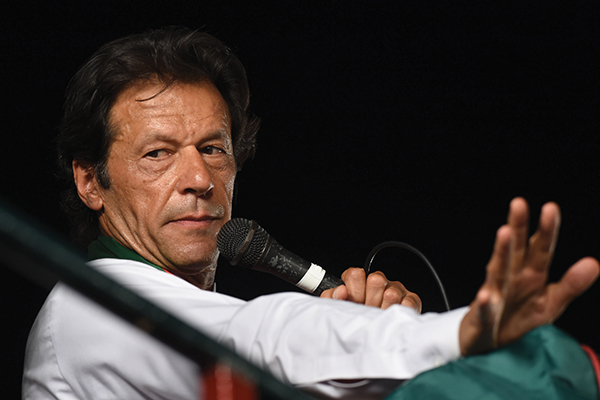
Imran Khan campaigning in Lahore’s NA-122 constituency on Oct. 4. Arif Ali—AFP
A country lurching right.
It was apparently the billion-rupee by-election.
The Oct. 11 race in Lahore’s NA-122 constituency between Ayaz Sadiq of the ruling Pakistan Muslim League (Nawaz) and Aleem Khan of the opposition Pakistan Tehreek-e-Insaf saw both campaigns rout the Election Commission of Pakistan’s per-candidate spending cap of Rs. 1.5 million. Together, both campaigns reportedly spent Rs. 1 billion but there’s not been a word of rebuke from the Commission.
Sadiq defeated Khan by a small margin of 2,444 votes, both parties lost Okara’s NA-144 constituency to an independent candidate, and the PTI defeated the incumbent PMLN lawmaker in Lahore’s PP-147 constituency. What lessons can we draw from these hotly contested by-elections?
The hotly contested race had temperatures high. Both parties ran negative campaigns, which were zero-sum undertakings with no words expressed about national vision or how to progress society or how to provide food, economic, health and environmental security. Instead, the PMLN alleged the PTI was funded by “Jewish money” and “Indian agencies,” and the PTI alleged that the “corrupt” PMLN was abusing state machinery for electoral advantage. The rhetoric from each side riled voters of the other side into coming out to vote.
There are at least three distinct voter segments in NA-122: middle-class traders, railway workers, and two major clans, the Arian and Kashmiris. An exit poll conducted here on May 11, 2013—when the last general elections were held—found that 57 percent of PTI voters earn between Rs. 10,000 and Rs. 30,000 per month, and that 58 percent of them have college degrees or at least intermediate education. So the PTI ought to be attracting a sizeable chunk of voters here. But, according to a survey in September, Sadiq had a 15-percent lead over Khan. He won with a razor-thin margin of 1.67 percent. What this means is that NA-122 has some 50,000 swing voters—and these voters will decide all future races in this constituency.
The results also show that the PMLN’s support in its urban strongholds is shrinking and, in order to compete with the PTI, it will have to induct new blood. As for the PTI, it needs to restructure its candidate-selection process and its chief, Imran Khan, needs to not take voters for granted; his presence in NA-122 on polling day would only have helped the campaign. The good news for the PTI is that it appears to finally be converting its robust rallies into actual votes, in urban areas. In rural constituencies—which account for 200 of the 272 directly elected seats in the National Assembly—the old thana-kutchery culture still prevails to the PTI’s disadvantage.
Oct. 11 was a bad day for the center-left Pakistan Peoples Party—which participated in the by-elections but might as well shouldn’t have. The stretch from Rawalpindi to Rahimyar Khan, with its 150 National Assembly constituencies, is now with the center-right PMLN and PTI. The PPP is relegated to the impoverished and illiterate Thattha-to-Sukkur stretch.
Saleem is co-host of Ho Kya Raha Hai on 92 News. From our Oct. 17-31, 2015, issue.
